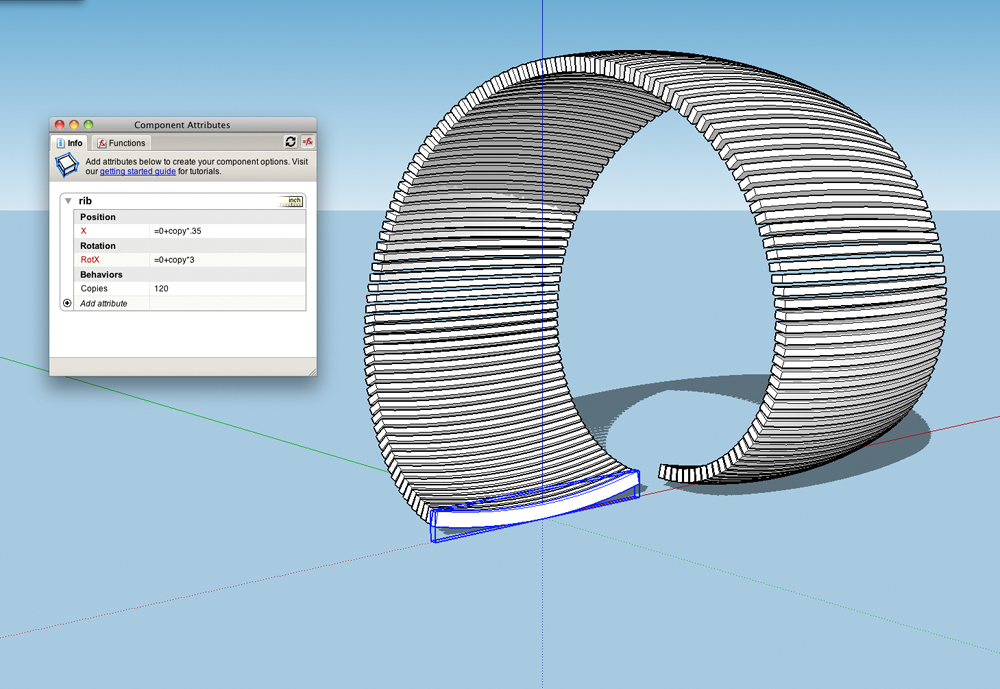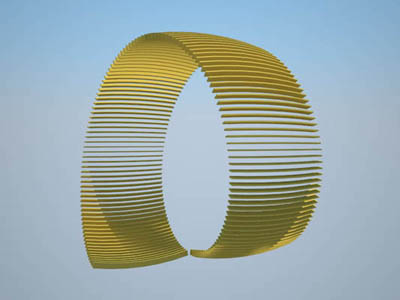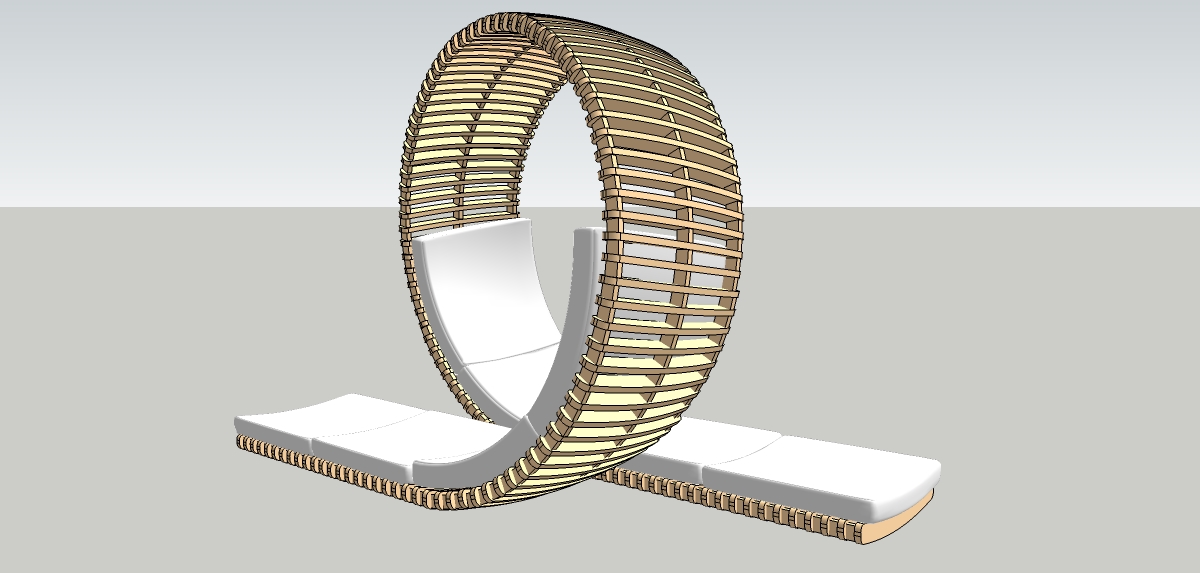MODEL THIS: Loopita Bonita Lounger
-
Rich, that looks great, I never use DC's so I'm stumped.
I want to use some sort of stringer but cannot find one that strings perpendicular to the path...anyone know if one exists?
-
re: the DC.. look at the screen shot --

those are all the functions i used showing in the component attributes dialog..
i made the rib and set it's axes to 2 1/2' above it as i figured i'd make a 5' inner radius.. (this is changeable if you want and i'll include a height example in the user friendly dc i make of this)..
i put 120 for the amount of copies meaning the rib component will be copied 120 times.. for rotX (rotation around the X axis) i put:
RotX=0+copy*3
which means the first rotated copy will be rotated 0º then every copy there after will be rotated 3º (and 3º * 120 copies = a full circle)for position X (position along the red axis), i put:
PosX = 0+copy.35"*
which means the first copy will not move sideways along the red (or 0) then each copy after that will shift .35" to the right along the red.. -
I never thought to use a Ruby function. Great idea Jeff. You could probably get the same result by doing the maths then manually moving/rotating the second instance relative to the first, then using AdamB's xformclone.rb which appears in this thread. Obviously, this can be done on the free version.
[Edit] Yes...works a treat. I've got RSI now, though.


-
I'm going to try to model this for FormFonts. In order to save polygons I'm going to probably ignore stuff like the doubling up of ribs where each section joins the next; and just do a straight array like the ones posted so far.
However, I would like to get the geometry right...and it's more complicated than at first sight. You'll notice that the ribs are level at the beginning and end...and also at the TDC...but they they are noticeably banked (like a real rollercoaster) as they go up each side of the loop. That's another function that will need to be calculated.
Once the ribs are looking correct; rather than building separate rails, it's probably going to be easier to simply draw the rail profiles on one of the rib components and P/P them to join onto the adjacent one. That will probably require unique components for the flat section at either end, as the rails on the loop are going to have to be slightly skewed. -
I see that there are segments of approximately 120 degrees. And they are twisted. This is obvious. Your tests are similar, but incorrect, because the segments are the horizontal and rotated about two points



-
@alvis said:
Your tests are similar, but incorrect....
Strange that I should get the same result then.

-
I was talking about the first examples
 . your test is really similar
. your test is really similar 
-
Ah! I misunderstood. Great model BTW.
I could see that the actual construction was made up of maybe a dozen sections of 8 or 9 ribs each, so I decided to just do a single array of 96 ribs.
If anyone wants to try this from scratch (actual dimensions unknown):-
Make a single rib component 30" wide.
Make a 5' disc at the side as in alvis's image...to get the centre of rotation for the loop.
Make a rotated copy of the rib at 3.75 deg, then using the Move tool on the rotate handles, rotate it by -0.7 deg.
Activate the xcopyclone.rb until your finger drops off or you get a complete loop...whichever comes sooner. -
not bad not bad

-
I kept it as low poly as I could, but it still just topped 6000 faces.

-
Lots of impressive models here

Kind of a new twist on an Ottoman?If this piece comes flat-packed from IKEA I think I'll pass

-
OK, so who's up for the interior daisy-chain version?


-
here's a more user friendly version of the DC.
click on the component then.. Window->Component Options
this example shows one of the major letdowns of DCs (and what i'd love for the SUteam to fix!)..you can't move a component relative to it's axes without stretching it.. so, in order to get proper height control, i had to place the rib component inside another DC.. what this does is create multiple component definitions upon copying which leads to big files sizes/bad performance etc..
obviously not fine tuned etc as i don't have much time to spend on it but you get the idea.
-
.
btw - here are a few real world loops i've built

@2:20 =

[flash=500,400:2e8irx04]http://www.youtube.com/v/g5ww2vK9n-s?fs=1&hl=en_US[/flash:2e8irx04]so i almost killed t.hawk once

[flash=500,400:2e8irx04]http://www.youtube.com/v/2ZLUZl8sdgY?fs=1&hl=en_US[/flash:2e8irx04]that ^^^ same loop -- convertible style

[flash=500,400:2e8irx04]http://www.youtube.com/v/oJV40gmUtmI?fs=1&hl=en_US[/flash:2e8irx04]taking the open top loop idea a bit further.. open top corkscrew:
[flash=500,400:2e8irx04]http://www.youtube.com/v/khHTAPr-1P0?fs=1&hl=en_US[/flash:2e8irx04]can't really find decent videos online of all of them/variations..
-
Seems a very dangerous model!

It's near Paraplegia for some skate users!
-
Nice work on those real ones Jeff. You got skills man.
I never expected so many great models this soon. You guys are awesome.
-
WIP.
Used copy along path (after I figured out how to keep the groups perpendicular)

-
I've done it by hand... no speedmodelling here
 but by hand is more like doing one little bar, copy+rotate it 17 times, move each copy a few mm. Copy+rotate those 7 times, move each one the appropriate distance as well... so it's not really a helix I guess. no torque. just a shear.
but by hand is more like doing one little bar, copy+rotate it 17 times, move each copy a few mm. Copy+rotate those 7 times, move each one the appropriate distance as well... so it's not really a helix I guess. no torque. just a shear.
And for the final touch, the hand grips or whatever for each segment. You guys all left those out I think... plus the fact that the distance is different there... Anyway. don't mean to be critical I omitted some stuff too. Like, the cushions. Sorry cushions.
I omitted some stuff too. Like, the cushions. Sorry cushions.
So here's my pic. Enjoy.

-
Another great one Martha. Well done.
Advertisement







